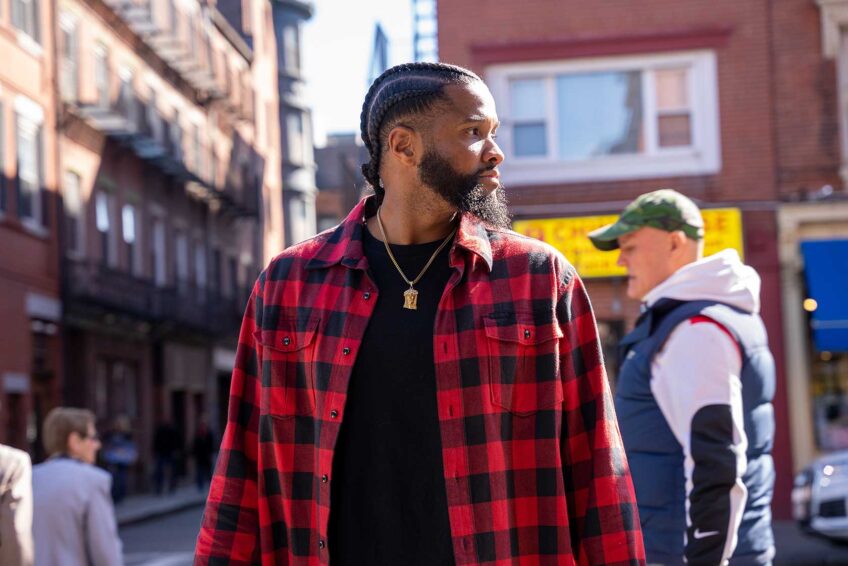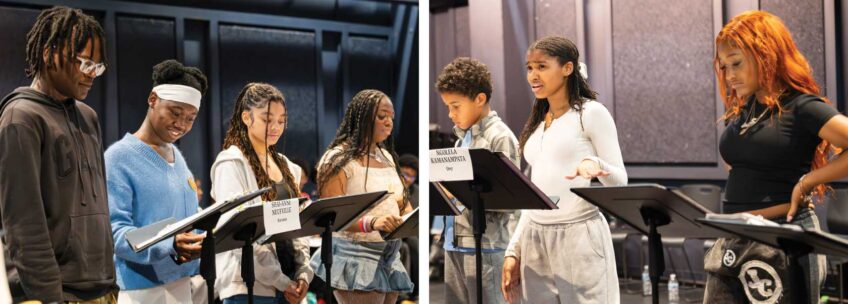The Colored Museum at The Huntington Theatre Company is satire served up with wit, insight

Delirious and at moments devastating, the Huntington Theatre Company’s revival of “The Colored Museum,” by two-time Tony Award winner George C. Wolfe, would be worth seeing for the verve and finesse of the cast alone. But the production, on stage through April 5 at the Avenue of the Arts/BU Theatre, renders the wit, style and satire of this 1986 show with an up-to-the-minute edge.
When Wolfe, a consummate theater artist and truth-teller, created this pioneering show, his career had not yet begun its ascent. But soon after, awards and recognition came for writing and staging powerful shows such as Savion Glover’s “Bring ‘da Noise, Bring in ‘da Funk;” his musical about jazz musician Jelly Roll Morton, “Jelly’s Last Jam;” and “Spunk,” a jazz rendering of Zora Neale Hurston stories that kept their rage intact.
The production’s director and choreographer is Billy Porter, who won multiple awards, including a Tony, for his portrayal of Lola in the Broadway musical “Kinky Boots.” Porter brings a sensibility for multi-media spectacle that suits the show and Wolfe’s highly specific stage directions, which call for an all-black cast and use of projections and recorded music, with the sole exception of a percussionist.
Porter’s staging orchestrates sets by Clint Ramos, Zachary Borovay’s projections, costumes by Anita Yavich, lighting by Driscoll Otto, with sound design by John Shivers and Kevin Kennedy and music by Kysia Bostic.
The show opens with a spare set — a crate — out of which 300 years of African-American history will spill in a fast-moving, intermission-free hour and 45 minutes.
Posing on pedestals like exhibits in a wax museum, the show’s characters come to life in brief vignettes. Percussionist Aikili Jamal Haynes weaves in and out of scenes, summoning with his drums a communal spirit across time.
A pert hostess in a pink mini-dress, Shayna Small welcomes the audience aboard the Celebrity Slaveship, announcing that “shackles must be worn at all times.”

Author: Photo by T. Charles EricksonCapathia Jenkins as Aunt Ethel in the Huntington Theatre Company production of “The Colored Museum.”
In the next scene, the magnificent Capathia Jenkins is an Aunt Jemima figure in her bright plaid smock and head wrap over a vat. She hosts “Cookin’ with Aunt Ethel,” and with a great blues-belting voice introduces the secrets of “colored cuisine.”
Show-stealer
Another show-stealer, Rema Webb, partners with the elegant Nathan Lee Graham as the ultimate urbane couple, against a backdrop of Ebony magazine covers.
Aretha Franklin’s immortal “Respect” introduces a scene between two wigs who quarrel over which of them should be worn by their owner — Graham — who is about to break up with a boyfriend. As Smalls insists on her smooth cap and Jenkins argues for her wild Afro, their verbal battle crests in cacophonous excess.
Style and attitude trump heartache in Graham’s portrayal of a cross-dressing diva in a bar named the Bottomless Pit.
Ken Robinson plays a soldier whose marksmanship takes a misguided turn. In another scene, he is a man in a business suit who is discarding his past. As Smokey Robinson croons “My Girl,” he hurls keepsakes into a trash bin that include his first Afro comb, a signed photo of Stokely Carmichael, and albums by the Temptations and Stevie Wonder.
Sending up the anguished son in Lorraine Hansberry’s 1959 play “A Raisin in the Sun,” Robinson plays Walter-Lee-Beau-Willie in “The Last Mama-on-the-Couch Play.” Jenkins, the Mama, wears a floral dress that matches the couch and wallpaper of her apartment, which overlooks shabbier tenements next door. As her son enters, Mama insists that he wipe his feet, no matter how defeated he feels by the “Bossman” who “is wiping his feet on me.”
When Walter curses, Mama mimes a slap and Robinson in slow motion crumples to the floor. Webb is hilarious as his wife, a self-absorbed New Age princess, and Small is assured as his sister, an affected Julliard graduate.
The debonair Graham, again in tux, narrates the vignette, which also mocks the relentless high spirits of some Broadway shows. Pining for the cheer of an all-black show in which “everybody is happy,” Mama says, “Nobody ever dies in an all-black musical.”
Webb is terrific as French émigré and singer Lala, who claims artistic lineage with expatriate French singer Josephine Baker. When mysterious letters threaten to reveal a murkier past, she protests, “My clothes are too fabulous! My hair is too long! My accent too French!”
“The Colored Museum” is often described as a forerunner to the 1990s TV satirical sketch series “In Living Color,” with the Wayans brothers and Jim Carrey. But this pioneering show, which Wolfe first staged in 1986, has more in common with “Forbidden Broadway,” which parodies Broadway hits with such finesse that the send-ups are as entertaining as the original shows.
While every bit as entertaining as these satirical reviews, unlike these shows, “The Colored Museum” also packs the occasional punch. Wolfe’s true targets are a tendency in black entertainment toward obligatory uplift that denies pain as well as the individual agony of denying one’s own self.
Guided by party-going Topsy (Webb), the finale offers an apotheosis, a gathering of immortals — Ella, Louis, the Duke, Malcolm X, Angela Davis and more — at a party “way-way uptown…between 125th Street and infinity.” Topsy says, “I been thinking we gave up our drums. But, naw, we still got ‘em. I know I got mine…And everything I need to get over in this world is inside here, connecting me to everybody and everything that’s ever been.”
For ticket information go to www.huntingtontheatre.org – use the Code BANNER when purchasing tickets for discounted ticket price.






